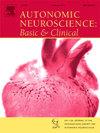covid -19后体位性站立性心动过速综合征(PC-POTS)患者血清定量蛋白质组学分析发现生物标志物
IF 3.2
4区 医学
Q2 NEUROSCIENCES
引用次数: 0
摘要
体位性站立性心动过速综合征(POTS)是一种慢性衰弱性疾病,其特征是在站立性挑战时心率过度增加。在COVID-19大流行之前,POTS影响了0.5%至1%的美国人口。自大流行以来,发病率急剧上升,在美国估计增加了600万至700万新病例,尽管它很重要,但目前还没有可靠的生物标志物来诊断POTS,导致严重的诊断延误。识别生物标志物的一个主要障碍是该综合征的异质性。为了解决这个问题,我们重点研究了一组同质的covid -19后POTS (PC-POTS)患者。我们对9名PC-POTS患者和9名健康对照者的血清进行了定量蛋白质组学分析,鉴定出31种在PC-POTS患者中丰度显著不同的蛋白质。大多数升高的蛋白与肌动蛋白丝或免疫功能/炎症有关。加权基因共表达网络分析显示,模块7 (M7)与PC-POTS的诊断及相关性状密切相关。M7的关键蛋白包括MTPN、TAGLN2、adp -核糖基化因子1、PDLIM1、PPIA、CNN2、LGALSL、TXN、TLN1、TUBA4A、IL4、TREML1、GP1BA,均与这些性状高度相关。细胞型富集分析显示M7与免疫细胞和神经元细胞高度相关。在M7中发现的主要途径包括整合素信号通路、凝血和糖酵解。这些发现表明M7中的关键蛋白可以作为PC-POTS的生物标志物。本研究利用定量蛋白质组学技术鉴定PC-POTS患者与健康对照的潜在生物标志物,为进一步研究和验证奠定基础。本文章由计算机程序翻译,如有差异,请以英文原文为准。
Quantitative serum proteomic analysis for biomarker discovery in post-COVID-19 postural orthostatic tachycardia syndrome (PC-POTS) patients
Postural orthostatic tachycardia syndrome (POTS) is a chronic, debilitating condition that is characterized by an excessive increase in heart rate upon orthostatic challenge. Before the COVID-19 pandemic, POTS affected 0.5 % to 1 % of the U.S. population. Since the pandemic, the incidence has risen sharply, adding an estimated 6–7 million new cases in the U.S. Despite its importance, there is currently no reliable biomarker for POTS, leading to significant diagnostic delays. A major hurdle in identifying biomarkers is the heterogeneous nature of the syndrome. To address this, we focused on a homogeneous subgroup of post-COVID-19 POTS (PC-POTS) patients. We conducted quantitative proteomics on sera from 9 PC-POTS patients and 9 healthy controls, identifying 31 proteins with significantly different abundances in PC-POTS patients. Most elevated proteins were linked to actin filaments or immune functions/inflammation. Weighted Gene Co-Expression Network Analysis revealed module 7 (M7) correlated strongly with PC-POTS diagnosis and related traits. The key proteins in M7 included MTPN, TAGLN2, ADP-ribosylation factor 1, PDLIM1, PPIA, CNN2, LGALSL, TXN, TLN1, TUBA4A, IL4, TREML1, GP1BA, and, all highly correlated with these traits. Cell-type enrichment analysis revealed that M7 was highly associated with immune and neuronal cells. The main pathways identified in M7 included the integrin signaling pathway, blood coagulation, and glycolysis. These findings suggest that the key proteins in M7 could serve as biomarkers for PC-POTS. This study uses quantitative proteomics to identify potential biomarkers that differentiate PC-POTS patients from healthy controls, establishing a foundation for further research and validation.
求助全文
通过发布文献求助,成功后即可免费获取论文全文。
去求助
来源期刊
CiteScore
5.80
自引率
7.40%
发文量
83
审稿时长
66 days
期刊介绍:
This is an international journal with broad coverage of all aspects of the autonomic nervous system in man and animals. The main areas of interest include the innervation of blood vessels and viscera, autonomic ganglia, efferent and afferent autonomic pathways, and autonomic nuclei and pathways in the central nervous system.
The Editors will consider papers that deal with any aspect of the autonomic nervous system, including structure, physiology, pharmacology, biochemistry, development, evolution, ageing, behavioural aspects, integrative role and influence on emotional and physical states of the body. Interdisciplinary studies will be encouraged. Studies dealing with human pathology will be also welcome.

 求助内容:
求助内容: 应助结果提醒方式:
应助结果提醒方式:


